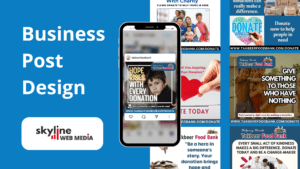Defining Lead Generation
Let’s start with that all-important textbook definition:
Wikipedia says that lead generation is ‘the initiation of consumer interest or inquiry into products or services of a business.’
In other words, it’s the spark that ignites interest in strangers about what it is that your business does, hopefully, ‘leading’ to some well-earned sales (see what we did there?).
Leads are essentially people who have warmed up to you and what you’re selling. They’re potential customers that are ripe for the picking.
Using effective lead generation strategies, your marketing team should be able to supply your sales team with a whole bunch of leads to keep your business continuously growing.
Marketing 101
If you’ve ever looked into marketing tactics before you’ve probably become pretty well acquainted with pictures of funnels.

As you can see from the image above, leads sit in the middle of the funnel, acting as a threshold between visitors who are just dipping their toes in the pool of your business and those who are bonafide customers.
Lead generation is all about giving those visitors a little nudge so that they move further down through your marketing funnel.
However, as proponents of Inbound Marketing strategies, we tend to be more of a fan of flywheels than funnels.
Whereas the funnel is a one-way system, flywheels help to store momentum by using happy customers to drive referrals and repeat sales.

If you view the marketing process as a flywheel, it’s helpful to understand that lead generation occurs in the ‘Engage’ stage of this process. Engaging your captive audience (rather than giving them the hard sell) is the name of the game. By building trust and a great reputation amongst visitors to your site, you can start to tip the scales toward new sales.

Lead generation is the spark that ignites interest in strangers about what it is that your business does, hopefully, ‘leading’ to some well-earned sales.
But, how do you turn a prospect into a lead?
For an in-depth explanation of this process, it’s best if you check out our Ultimate Guide to Lead Generation for Small Businesses, where you can find a handy infographic describing our five-step process for generating leads.
But, simply put, prospects become leads when they indicate interest in your company’s product or service.
So in order to generate a lead, you need to provide measurable indications of interest on your website (such as forms or specific links) and encourage your visitors to interact with them.
One of the best ways to do this is to offer your visitors useful downloadable content in return for their personal details.
The journey for your potential lead looks like this:
- First, they discover your business either through your website, blog, or social media.
- Then, they click on a call-to-action (an image or a button that encourages them to take some sort of action).
- This call-to-action takes them to a landing page where they are offered a piece of premium content (a lead magnet) in exchange for their personal details.
- Your visitor fills in a form on the landing page to complete this transaction.
Why is lead generation important?
It should be obvious by now that lead generation is an essential part of running a successful business.
This is because in order to maintain a thriving business, you always need to keep one eye on the future at all times, and running lead generation campaigns enables you to do this.
These campaigns build a strong foundation for future sales by helping to increase your client base and, consequently, your revenue.

Additionally, lead generation also helps to build a positive reputation amongst potential customers by positioning your business as a leader in its field.
By offering visitors to your website useful and educational content, you’re able to engage with consumers on their own terms rather than foisting yourself onto them with intrusive outbound tactics.
Inbound lead generation specifically builds trust and an environment in which consumers will feel as though their decision to buy from you is an organic one.
Investing in lead generation ultimately helps you to really put customers at the heart of your business.
Source: https://www.growfox.co.uk/blog/what-is-lead-generation-and-why-is-it-important-a-beginners-guide


















